
Wine Culture and Information since 2002 - Volume 22
 Wine Culture and Information since 2002 - Volume 22 |
|
Comparing Sforzato di ValtellinaFrom the Nebbiolo grape, one of the best expressions of Valtellina's enology, a great wine rich and intense of deep emotions and impeccable class |
|
Nebbiolo is one of the many grapes of the Italian wine scene which has gone outside the borders of the country bringing the excellence of Italian wine in the world. Capable of making wines of full body and elegant class, Nebbiolo is frequently defined as an iron fist in a velvety glove. This definition is in fact pretty appropriate for wines produced with Nebbiolo, wines which after the initial impact caused by their remarkable structure followed by an evident crispness, amaze senses with their undeniable class and elegance. Two are the areas in which Nebbiolo wines are being produced: Piedmont - in particular the Langhe area - and Valtellina in Lombardy. Two territories very different one from each other with distinct climate and environmental characteristics and from which are produced two interesting expressions of Nebbiolo wines. Nebbiolo is a grape which tends to ripe later than other varieties, in that period of the autumn in which in the Langhe area arrives the fog (nebbia in Italian), an event which probably has inspired the name of the grape. Three are the main qualities characterizing Nebbiolo grape. First of all, its high contents in polyphenols and tannins - it is among the red berried grapes with the highest content in these substances - high acidity and moderate coloring quality. Despite its remarkable body, and which would make one thinks about wines with deep and intense colors and a very low transparency, wines produced with Nebbiolo are generally characterized by a moderate transparency and colors having garnet red colors, as well as brick red, also after few years of aging. A grape difficult to cultivate and to vinify, the production of great wines with Nebbiolo is a wine making practice requiring lots of efforts as well as using very high quality procedures, and - of course - a territory suited for its cultivation.
|
|
In Valtellina Nebbiolo is considered as an autochthonous grape and, despite today in this area it is preferred to call it with its most famous name, in the past it was known as Chiavennasca, a name still used today by some producers. In Valtellina, where the environmental conditions and the morphology of the territory, rich in mountains and steep slopes forcing a pretty hard viticulture, Nebbiolo grape is found in every traditional wine of the area, in which is sometimes added Pignola, Rossola and Brugnola. Undisputed celebrity of Valtellina is Sforzato. This excellent wine is produced by allowing grapes to dry before being crushed and vinified. This procedure allows a loss of water and a concentration of sugar, with the result of obtaining an intense wine and a robust structure. Sforzato di Valtellina is characterized by strong and complex aromas, qualities which become even stronger after some years of aging, a factor which, besides the other things, smooths the astringency of Nebbiolo while making it excellently round and balanced.
In our comparative tasting we will examine three excellent Sforzato di Valtellina, all of them being produced with 100% Nebbiolo, with the only difference in the period and type of container used for aging. Two of these wines have been aged in barrique and only one of them has been aged in cask. The first wine selected for our comparative tasting is Conti Sertoli Salis' Sforzato di Valtellina Canua, aged for 2 years in barrique. The second wine is Triacca's Sforzato di Valtellina San Domenico, the only one of the three to be aged in cask for a period of 18 months. The last wine of our comparative tasting is Mamete Prevostini's Sforzato di Valtellina Albareda, aged for 20 months in barrique. The wines will be of the latest available vintage and served at the temperature of 18° C. (64° F). As usual, the wines will be poured in three ISO tasting glasses.
|
||||||||
|
Wines produced with Nebbiolo grape are generally characterized by a moderate transparency, however showing pretty bright and brilliant colors. Nebbiolo does not have a high coloring property, a characteristic which is found in most of the wines produced with this grape. Sforzato di Valtellina represents an exception to this characteristic. The drying of grapes gives in fact a higher concentration of colors, therefore the transparency in Sforzato can sometimes be pretty low. The color generally observed in Sforzato della Valtellina is a pretty intense and brilliant ruby red, with nuances of garnet red also in the first years of aging. As time and aging go by, the color in Sforzato becomes garnet red and in the nuances can be observed a brick red color, a characteristic that in some Sforzatos is visible also after few years of aging. We will begin the appearance evaluation of our wines from Conti Sertoli Salis' Sforzato di Valtellina Canua. We will examine the color of this wine by tilting the glass over a white surface - for example a sheet of paper or a napkin - and by observing the wine at the base of the glass. It will be observed a brilliant ruby red color and a moderate transparency. Nuances - observed at the edge of the liquid mass towards the opening of the glass - will be characterized by a brick red color. Let's now pass to the evaluation of the second wine: Triacca's Sforzato di Valtellina San Domenico. The color of this wine is intense ruby red, darker than the previous wine, with brick red nuances. It should be noticed how the transparency in this wine is similar to the previous one. The evaluation of the third wine, Mamete Prevostini's Sforzato di Valtellina Albareda, will show a brilliant ruby red color and nuances of brick red. Also in this case transparency is pretty high, similar to what has been observed in the previous wines.
|
|
Thanks to its characteristics, to its capability of standing to long periods of aging and to the wine making techniques usually adopted with this grape, wines produced with Nebbiolo are generally generous according to an olfactory point of view, giving to the nose aromas of fruits and flowers as well as a pretty complex tertiary profile. Complexity is increased in Sforzato di Valtellina also thanks to the practice of the drying of grapes, a technique which concentrates the substances found in the berries, including aromas. The main fruit aromas which can be perceived in Sforzato are cherry, raspberry, plum, blueberry and strawberry, also in the form of jam, and sometimes blackberry. The world of flowers in Sforzato gives the nose aromas of violet and rose, both being very characteristic in Nebbiolo. Rich is also the group of spicy and tertiary aromas, such as licorice, vanilla, mace, leather, chocolate, cocoa, tobacco, cinnamon, menthol and, after some years of aging, from the glass can also be perceived a hint of tar. The wine from which we will begin the evaluation of aromas is Conti Sertoli Salis' Sforzato di Valtellina Canua. By holding the glass in vertical position and without swirling, we will do a first smell in order to evaluate opening aromas, that is the aromas made from “light” aromatic substances. From the glass it will be possible the perception of the aromas of cherry, dried violet and prune, three aromatic qualities very typical in Sforzato and in wines produced with Nebbiolo grape. We will now proceed with the swirling of the glass in order to favor the volatilization of “heavy” aromatic substances, therefore completing the olfactory profile of the first wine of our comparative tasting. From the glass will be perceived aromas of dried rose, pink pepper, vanilla, tobacco, star anise, cinnamon, cocoa, licorice, mace, leather and a pleasing balsamic hint of menthol. Let's now pass to the evaluation of the second wine of our comparative tasting, Triacca's Sforzato di Valtellina San Domenico. By holding the glass in vertical position and without swirling, we will proceed with the evaluation of opening aromas in which will be perceived cherry, plum and violet, not so different from the previous wine. After having swirled the glass, the olfactory profile of this wine will be completed by aromas of blackberry, blueberry, raspberry, cyclamen and dried rose followed by the more complex aromas of vanilla, tobacco, chocolate, cinnamon, leather and menthol. Let's now proceed with the evaluation of the last wine: Mamete Prevostini's Sforzato di Valtellina Albareda. The opening of this Sforzato is characterized by aromas of cherry, violet and plum to which follow the complex aroma of leather. After having swirled the glass, the olfactory profile will be completed by rose, raspberry, vanilla, tobacco, cocoa, cinnamon, clover, licorice, mace, cinchona and the usual balsamic hint of menthol. Finally, it is interesting to compare the impact of the different types of casks and the aging period on the aromatic profile of each wine.
|
||||
|
An iron fist in a velvety glove. This is how are generally defined wines produced with Nebbiolo because of their remarkable structure and astringency which is added to the elegance and class, while showing a refreshing crispness, pretty unusual to be found in a red wine. Nebbiolo is in fact one of the red berried grapes having the highest content in polyphenols, a characteristic which is always found in its wines and expressed by an evident astringency. In order to smooth Nebbiolo's harshness, wines are allowed to age for many months, sometimes for many years, in casks - as well as barriques - a procedure which will increase both body and roundness. In Sforzato roundness is also increased by the drying of grapes, a quality which makes this wine unique in the group of wines made with Nebbiolo grape. Another characteristic of Sforzato is the high content in alcohol, result of the concentration of sugar during the drying of gapes and useful for balancing the wine, which can sometimes be 15%. The first wine of which we will examine taste is Conti Sertoli Salis' Sforzato di Valtellina Canua. In the attack of this Sforzato is very clear the nature of this excellent wine from Valtellina: a tannic attack supported by an appreciable crispness, remarkable structure and a pleasing roundness. It should also be noticed how the alcohol contributes to the balancing of astringency and acidity. Also the attack of the second wine - Triacca's Sforzato di Valtellina San Domenico - is not so different from the previous wine: astringency and crispness well balanced by a pleasing roundness and by alcohol. Also in this case the structure is evidently robust. Let's now pass to the last wine of our comparative tasting: Mamete Prevostini's Sforzato di Valtellina Albareda. Once again, it will be noticed a tannic attack supported by a pleasing crispness, well balanced by alcohol and roundness. It should be noticed the excellent correspondence to the nose in all the three wines, in particular cherry and plum.
|
|
One of the many excellent qualities of Sforzato di Valtellina is represented by the long persistence which can be perceived in the mouth after having swallowed the wine, as in the case of our three wines. The finish of Conti Sertoli Salis' Sforzato di Valtellina Canua is very persistent and leaving in the mouth intense and clean flavors of cherry and plum, very characteristic in wines produced with Nebbiolo. Also the finish of Triacca's Sforzato di Valtellina San Domenico is very persistent with long and intense flavors of cherry, plum and blackberry, very agreeable. Very similar is the the finish of the third wine - Mamete Prevostini's Sforzato di Valtellina Albareda - characterized by a very long persistence with intense, clean and pleasing flavors of cherry, plum and raspberry. It should also be noticed how the robust body and crispness continue to be perceived after having swallowed the wine.
|
Wines of the Month |
|
|
|
Score legend Prices are to be considered as indicative. Prices may vary according to the country or the shop where wines are bought |
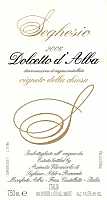
|
|
Barbera d'Alba Vigneto della Chiesa 2004 |
|
| Seghesio (Piedmont, Italy) | |
| Grapes: Barbera | |
| Price: € 17.00 | Score: |
| Dolcetto d'Alba Vigneto della Chiesa shows an intense ruby red color and nuances of purple red, little transparency. The nose reveals intense, clean pleasing and refined aromas that start with hints of cherry, plum and blueberry followed by aromas of violet, raspberry, blackberry, cyclamen, almond and carob. The mouth has good correspondence to the nose, a slightly tannic attack and however balanced by alcohol, good body, intense flavors, agreeable. The finish is persistent with flavors of cherry and plum. Dolcetto d'Alba Vigneto della Chiesa ages for 9 months in steel tanks. | |
| Food Match: Stuffed pasta with mushrooms, Sauteed meat, Stewed meat with mushrooms | |
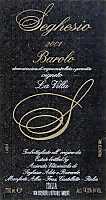
|
|
Barolo Vigneto la Villa 2001 |
|
| Seghesio (Piedmont, Italy) | |
| Grapes: Nebbiolo | |
| Price: € 36.00 | Score: |
| Barolo Vigneto la Villa shows a brilliant ruby red colors and nuances of brick red, moderate transparency. The nose reveals intense, clean, pleasing, refined and elegant aromas which start with hints of cherry macerated in alcohol, raspberry and violet followed by aromas of plum, strawberry, vanilla, tobacco, licorice, cinnamon, chocolate, clover, leather and menthol. The mouth has good correspondence to the nose, a tannic attack and pleasing crispness, however balanced by alcohol, full body, intense flavors, agreeable. The finish is persistent with flavors of cherry, plum and raspberry. A well made wine. Barolo Vigneto la Villa ages for 24 months in barrique. | |
| Food Match: Game, Roasted meat, Braised and stewed meat, Hard cheese | |
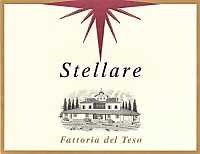
|
|
Stellare 2003 |
|
| Fattoria del Teso (Tuscany, Italy) | |
| Grapes: Syrah | |
| Price: € 8.00 | Score: |
| Stellare shows an intense ruby red color and nuances of garnet red, little transparency. The nose reveals intense, clean, pleasing and refined aromas that start with hints of black cherry, plum and black currant followed by aromas of violet, vanilla, tobacco, chocolate, black pepper and eucalyptus. The mouth has good correspondence to the nose, a tannic attack and however balanced by alcohol, good body, intense flavors, pleasing roundness. The finish is persistent with flavors of black cherry, plum and black currant. Stellare ages for 12 months in barrique followed by 4 months of aging in bottle. | |
| Food Match: Roasted meat, Broiled meat and barbecue, Stewed and braised meat with mushrooms, Hard cheese | |
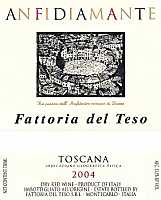
|
|
Anfidiamante 2004 |
|
| Fattoria del Teso (Tuscany, Italy) | |
| Grapes: Sangiovese, Syrah, Merlot, Cabernet Sauvignon | |
| Price: € 18.00 | Score: |
| Anfidiamante shows an intense ruby red color and nuances of ruby red, little transparency. The nose reveals intense, clean, pleasing and refined aromas that start with hints of black cherry, plum and black currant followed by aromas of blueberry, violet, vanilla, chocolate, tobacco, eucalyptus and mace. The mouth has good correspondence to the nose, a tannic attack and however balanced by alcohol, good body, intense flavors, agreeable. The finish is persistent with flavors of black cherry and plum. Anfidiamante ferments in barrique and ages for 12 months in bottle. | |
| Food Match: Roasted meat, Stewed and braised meat, Hard cheese | |
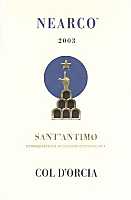
|
|
Sant'Antimo Rosso Nearco 2003 |
|
| Col d'Orcia (Tuscany, Italy) | |
| Grapes: Merlot (50%), Cabernet Sauvignon (30%), Syrah (20%) | |
| Price: € 25.00 | Score: |
| Sant'Antimo Rosso Nearco shows an intense ruby red color and nuances of garnet red, little transparency. The nose reveals intense, clean, pleasing and refined aromas that start with hints of black cherry, plum and black currant followed by aromas of tobacco, vanilla, blackberry, chocolate, eucalyptus, mace, black pepper and coffee. The mouth has good correspondence to the nose, a tannic attack and however balanced by alcohol, full body, intense flavors, agreeable. The finish is persistent with flavors of black cherry, plum and black currant. Sant'Antimo Rosso Nearco ages for 18 months in barrique followed by more than 12 months of aging in bottle. | |
| Food Match: Game, Roasted meat, Stewed and braised meat, Hard cheese | |
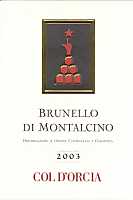
|
|
Brunello di Montalcino 2003 |
|
| Col d'Orcia (Tuscany, Italy) | |
| Grapes: Sangiovese | |
| Price: € 27.00 | Score: |
| This Brunello di Montalcino shows an intense ruby red color and nuances of garnet red, moderate transparency. The nose reveals intense, clean, pleasing, refined and elegant aromas which start with hints of black cherry, plum and violet followed by aromas of blueberry, vanilla, tobacco, licorice, chocolate, coffee, menthol and pink pepper. The mouth has good correspondence to the nose, a tannic attack and pleasing crispness, however balanced by alcohol, full body, intense flavors, agreeable. The finish is persistent with flavors of black cherry, plum and blueberry. A well made wine. This Brunello di Montalcino ages for 24 months in barrique followed by at least 8 months of aging in bottle. | |
| Food Match: Game, Roasted meat, Braised and stewed meat, Hard cheese | |

|
|
Stringaio 2005 |
|
| Fattoria La Torre (Tuscany, Italy) | |
| Grapes: Syrah (70%), Cabernet Sauvignon (30%) | |
| Price: € 12.00 | Score: |
| Stringaio shows an intense ruby red color and nuances of ruby red, little transparency. The nose reveals intense, clean, pleasing and refined aromas which start with hints of black cherry, plum and violet followed by aromas of blackberry, black currant, vanilla, tobacco, black pepper, chocolate and toffee. The mouth has good correspondence to the nose, a tannic attack and however balanced by alcohol, good body, intense flavors, agreeable. The finish is persistent with flavors of black cherry, plum and black currant. Stringaio ages for 12 months in barrique. | |
| Food Match: Roasted meat, Stewed meat with mushrooms, Hard cheese | |
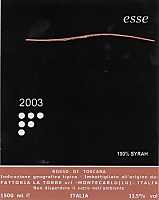
|
|
Esse 2003 |
|
| Fattoria La Torre (Tuscany, Italy) | |
| Grapes: Syrah | |
| Price: € 38.00 | Score: |
| Esse shows an intense ruby red color and nuances of garnet red, little transparency. The nose reveals intense, clean, pleasing, refined and elegant aromas which start with hints of black cherry, plum and black currant followed by aromas of blueberry, vanilla, tobacco, black pepper, chocolate, licorice, leather, eucalyptus and mace. The mouth has good correspondence to the nose, a tannic attack and however balanced by alcohol, full body, intense flavors, agreeable. The finish is persistent with flavors of black cherry, plum and black currant. Esse ages for 18 months in barrique followed by 6 months of aging in bottle. | |
| Food Match: Game, Roasted meat, Braised and stewed meat, Hard cheese | |
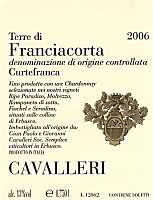
|
|
Terre di Franciacorta Bianco 2006 |
|
| Cavalleri (Lombardy, Italy) | |
| Grapes: Chardonnay | |
| Price: € 10.00 | Score: |
| Terre di Franciacorta Bianco shows a brilliant greenish yellow color and nuances of greenish yellow, very transparent. The nose denotes intense, clean and pleasing aromas which start with hints of apple, pear and banana followed by aromas of hawthorn, citrus fruits and plum. The mouth has good correspondence to the nose, a crisp attack and however balanced by alcohol, good body, intense flavors. The finish is persistent with flavors of apple, pear and banana. This wine ages in steel tanks. | |
| Food Match: Fried fish, Pasta and risotto with fish and crustaceans, Sauteed fish | |
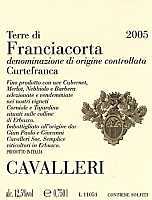
|
|
Terre di Franciacorta Rosso 2006 |
|
| Cavalleri (Lombardy, Italy) | |
| Grapes: Merlot (40%), Cabernet Sauvignon (25%), Cabernet Franc (15%), Barbera (10%), Nebbiolo (10%) | |
| Price: € 10.00 | Score: |
| This wine shows a brilliant ruby red color and nuances of garnet red, moderate transparency. The nose denotes intense, clean and pleasing aromas that start with hints of cherry, raspberry and plum followed by aromas of strawberry, cyclamen, tobacco and vanilla. The mouth has good correspondence to the nose, a slightly tannic attack and pleasing crispness, however balanced by alcohol, good body, intense flavors. The finish is persistent with flavors of cherry, raspberry and plum. Terre di Franciacorta Rosso ages for about 12 months in cask. | |
| Food Match: Stuffed pasta, Stewed meat with mushrooms, Broiled meat and barbecue | |
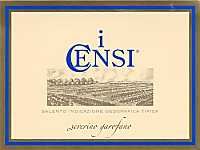
|
|
I Censi 2003 |
|
| Masseria Monaci (Apulia, Italy) | |
| Grapes: Negroamaro, Primitivo | |
| Price: € 7.30 | Score: |
| This wine shows an intense ruby red color and nuances of garnet red, moderate transparency. The nose denotes intense, clean, pleasing and refined aromas that start with hints of black cherry, plum and violet followed by aromas of blackberry, carob, star anise and tobacco. The mouth has good correspondence to the nose, a slightly tannic attack and however balanced by alcohol, good body, intense flavors. The finish is persistent with flavors of black cherry, plum and blackberry. | |
| Food Match: Stuffed pasta, Sauteed meat with mushrooms | |
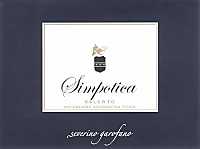
|
|
Simpotica 2003 |
|
| Masseria Monaci (Apulia Italy) | |
| Grapes: Negroamaro, Malvasia Nera, Montepulciano | |
| Price: € 9.00 | Score: |
| Simpotica shows an intense ruby red color and nuances of garnet red, moderate transparency. The nose denotes intense, clean, pleasing and refined aromas that start with hints of black cherry and plum followed by aromas of blackberry, dried violet, vanilla, tobacco, coffee, carob and menthol. The mouth has good correspondence to the nose, a tannic attack and however balanced by alcohol, good body, intense flavors. The finish is persistent with flavors of plum, black cherry and blackberry. | |
| Food Match: Roasted meat, Braised and stewed meat, Hard cheese | |
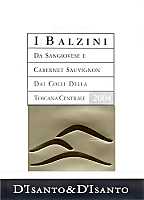
|
|
I Balzini White Label 2004 |
|
| I Balzini (Tuscany, Italy) | |
| Grapes: Sangiovese (50%), Cabernet Sauvignon (50%) | |
| Price: € 13.50 | Score: |
| I Balzini White Label shows an intense ruby red color and nuances of ruby red, little transparency. The nose denotes intense, clean, pleasing and refined aromas which start with hints of black cherry, plum and violet followed by aromas of blueberry, vanilla, carob, cinnamon, mace, tobacco and menthol. The mouth has good correspondence to the nose, a tannic attack and however balanced by alcohol, good body, intense flavors. The finish is persistent with flavors of black cherry and plum. I Balzini White Label ages for 12 months in barrique followed by at least 12 months of aging in bottle. | |
| Food Match: Broiled meat and barbecue, Roasted meat, Stewed meat with mushrooms, Hard cheese | |
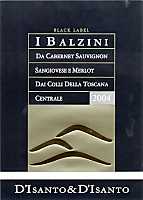
|
|
I Balzini Black Label 2004 |
|
| I Balzini (Tuscany, Italy) | |
| Grapes: Cabernet Sauvignon (50%), Sangiovese (25%), Merlot (25%) | |
| Price: € 24.00 | Score: |
| I Balzini Black Label shows a brilliant ruby red color and nuances of ruby red, little transparency. The nose reveals intense, clean, pleasing and refined aromas which start with hints of black cherry, plum and black currant followed by aromas of violet, blueberry, vanilla, tobacco, cocoa, cinnamon, mace and eucalyptus. The mouth has good correspondence to the nose, a tannic attack and however balanced by alcohol, good body, intense flavors, agreeable. The finish is persistent with flavors of black cherry, plum and black currant. I Balzini Black Label ages for about 16 months in barrique followed by at least 12 months of aging in bottle. | |
| Food Match: Roasted meat, Braised and stewed meat with mushrooms, Hard cheese | |
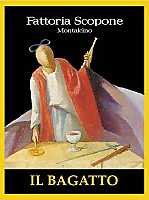
|
|
Il Bagatto 2003 |
|
| Fattoria Scopone (Tuscany, Italy) | |
| Grapes: Cabernet Sauvignon (40%), Merlot (40%), Sangiovese (10%), Petit Verdot (10%) | |
| Price: € 20.00 | Score: |
| Il Bagatto shows an intense ruby red color and nuances of ruby red, little transparency. The nose reveals intense, clean, pleasing and refined aromas that start with hints of black cherry, plum and black currant followed by aromas of violet, vanilla, tobacco, chocolate, cumin, rhubarb and eucalyptus. The mouth has good correspondence to the nose, a tannic attack and however balanced by alcohol, good body, intense flavors. The finish is persistent with flavors of black cherry, plum and black currant. Il Bagatto ages for 20 months in barrique followed by 12 months of aging in bottle. | |
| Food Match: Roasted meat, Stewed and braised meat with mushrooms, Hard cheese | |
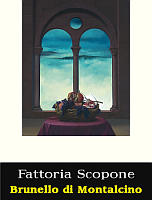
|
|
Brunello di Montalcino 2003 |
|
| Fattoria Scopone (Tuscany, Italy) | |
| Grapes: Sangiovese Grosso | |
| Price: € 25.00 | Score: |
| This Brunello di Montalcino shows an intense ruby red color and nuances of garnet red, moderate transparency. The nose reveals intense, clean, pleasing, refined and elegant aromas which start with hints of black cherry, plum and violet followed by aromas of blueberry, vanilla, tobacco, licorice, chocolate, coffee, menthol and pink pepper. The mouth has good correspondence to the nose, a tannic attack and pleasing crispness, however balanced by alcohol, full body, intense flavors, agreeable. The finish is persistent with flavors of black cherry, plum and blueberry. A well made wine. This Brunello di Montalcino ages for 24 months in barrique followed by at least 8 months of aging in bottle. | |
| Food Match: Game, Roasted meat, Braised and stewed meat, Hard cheese | |
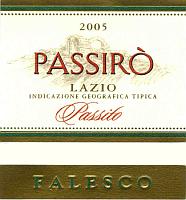
|
|
Passirò 2005 |
|
| Falesco (Latium, Italy) | |
| Grapes: Roscetto | |
| Price: € 10.00 - 385ml | Score: |
| Passirò shows a pale golden yellow color and nuances of amber yellow, transparent. The nose denotes intense, clean, pleasing and refined aromas which start with hints of dried apricot, peach jam and pear followed by aromas of almond, honey, vanilla, candied fruits, date, citrus peel and saffron. The mouth has good correspondence to the nose, a sweet attack and pleasing roundness, however balanced by alcohol, good body, intense flavors. The finish is persistent with flavors of dried apricot, honey and almond. Passirò ages in cask for 12 months. | |
| Food Match: Fruit tarts, Confectionery | |
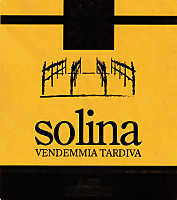
|
|
Solina 2005 |
|
| Cincinnato (Latium, Italy) | |
| Grapes: Malvasia del Lazio | |
| Price: € 16.00 - 500ml | Score: |
| Solina shows a deep golden yellow color and nuances of golden yellow, transparent. The nose denotes intense, clean, pleasing and refined aromas that start with hints of honey, almond and vanilla followed by aromas of date, dried fig, peach jam and nail polish. The mouth has good correspondence to the nose, a sweet attack and pleasing roundness, however balanced by alcohol, good body, intense flavors. The finish is persistent with flavors of dried fig, honey and almond. Solina is made from late harvested grapes and ages for 12 months in cask. | |
| Food Match: Fruit tarts, Confectionery | |
|
||||||||
|
DiWineTaste Polls
|
| |||||||
Privacy Policy | |||||||


| Copyright © 2002-2024 Antonello Biancalana, DiWineTaste - All rights reserved |
| All rights reserved under international copyright conventions. No part of this publication and of this WEB site may be
reproduced or utilized in any form or by any means, electronic or mechanical, without permission in writing from DiWineTaste. |